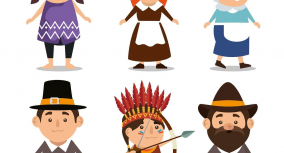Do you know what helps to investigate the piece of literature deeper? What reveals the hidden context and highlights the author’s key ideas? These are the symbols! And The Canterbury Tales include a lot of them. Explore our article and find everything about them.

Clothing
The readers get to know every pilgrim in the general prologue. The clothing and physiognomy play a crucial role in the portrayal of each character. They reflect the travelers’ background, highlight their personality traits, and determine social status.
Thus, appearance is one of the most significant symbols in The Canterbury Tales. Via the description of the character’s clothing, the author forms the readers’ opinions regarding the pilgrims.
The Knight and the Miller are the two central figures in the book, with their personality traits and social statuses contradicting each other. Chaucer’s description of their appearances highlights the difference between these two pilgrims.
The Knight is the first character the narrator introduces in The Canterbury Tales’ prologue. He is an honorable and courageous man who belongs to the high social class. Not only his deeds and behavior prove his nobility, but also his physical appearance. He wears his armors and has stains on his clothing. This indicates that he is not only showing off with his achievements, but he indeed commits feats. The neat clothes of his son, the Squire, also prove their nobility.
In contrast, Miller’s appearance is unattractive and sleazy. He wears old rags, has a messy beard, and a disgusting wart. His nasty look perfectly matches the low social class he belongs to. Creating completely contrasting character’s portraits, the author enhances the estates’ discrepancy effect.
Another traveler to Canterbury whose clothes attract much attention is the Wife of Bath. So, what does the Wife of Bath symbolize in the book? Sexual attraction? Lust? Her red stockings reflect her lustful nature, effectively proving her social status.
Besides, the Prioress’s elegant cloak and coral make her seem dainty, while she is bulky. So, in this case, the clothing hides the person’s true nature. In contrast, Oxford Cleric’s old and raggedy clothes highlight his poverty.
The ecclesiastical representatives’ physical appearance is essential for understanding the author’s core idea. Geoffrey Chaucer illustrates the religious branch as the most corrupted one in medieval England. Hence, church workers are portrayed unusually.
The Pardoner, the Summoner, the Monk, and the Friar are supposed to live a monastic and humble life. Their original mission is to preach Christian values and serve the worshipers. However, they mainly focus on getting profits, tricking people, and leading unethical lifestyles. They earn money, buy expensive clothes and jewelry, and live in luxury.
Quotes about Clothing
There was also a nun, a Prioress,
The Canterbury Tales, Narrator, The General Prologue
Her smile itself ingenuous and coy.
[…]
Her cloak was very elegant, I saw;
Fine coral round her arm she wore
A rosary, the larger beads were green,
And from it hung a brooch of golden sheen.
He was a very perfect gentle Knight.
The Canterbury Tales, Narrator, The General Prologue
But to tell of his equipment, his array,
His horses fine, he wore no colours gay
Sported a tunic, padded fustian
On which his coat of mail left many a stain;
For he was scarcely back from his voyage,
And going now to make his pilgrimage.
A good Wife was there from next to Bath,
The Canterbury Tales, Narrator, The General Prologue
But pity was that she was somewhat deaf.
[…]
Her kerchiefs were finely wove I found;
I dare to swear those weighed a good ten pounds,
That on a Sunday she wore on her head.
Here hose were of a fine scarlet red,
And tightly tied: her shoes full soft and new.
The MILLER was a strong man I own;
The Canterbury Tales, Narrator, The General Prologue
A stout fellow, big in brawn and bone.
[…]
His beard, as any sow or fox, was red,
And broad as well, as if it were a spade.
On the tip of his nose he displayed
A wart, and on it stood a tuft of hair,
Red as the bristles in a sow’s ear.
A Monk there was, of the highest degree
The Canterbury Tales, Narrator, The General Prologue
[…]
I saw his sleeves were trimmed at the wrist
With grey fur, and of the country’s finest;
And to fasten his hood beneath his chin,
He had a wrought-gold elaborate pin;
A love-knot in the larger end there was.
[…]
A Friar there was, a wanton one and merry,
A Limiter, a very jovial man.
[…]
Not like a friar from a cloister,
With threadbare cloak, like needy scholar,
But he was like a doctor or a pope;
Of double worsted was his demi-cloak,
A bell shaped from the mould, its fashion.
Language
The concept of The Canterbury Tales lies behind the story-telling competition. So, language plays a critical role in the book’s comprehension. The words used by Geoffrey Chaucer are symbolic. They reflect the truth of the actions. At the same time, they highlight the embellishment of certain parts of the piece of literature.
The Canterbury Tales is a unique piece of art since it combines both: reality and fiction. On the one hand, the readers witness the pilgrimage and can analyze travelers’ interactions. On the other hand, the book’s central part consists of the pilgrims’ tales. They usually contain lie and exaggeration elements.
The language of Chaucer can trace the fine line between fiction and reality. In the narrative parts, the author uses neutral language that does not awake any suspicions. However, when it comes to story-telling, Chaucer’s (the writer’s) vocabulary expands. He applies numerous literary devices, uses hyperboles, jargon, etc.
Similarly, the distinguished style helps the readers to distinguish the characters. If the Knight’s vocabulary is rich, the Miller uses rude and filthy words in his speeches.
The Canterbury Tales is a collection of numerous stories. Thus, the author utilizes the frame narrative to link all the tales in one piece of literature.
What is the frame narrative of The Canterbury Tales? It is the literary tool that ensures the cohesion of the book. Probably, Chaucer borrowed this idea from Boccaccio’s Decameron.
Another piece of art Geoffrey Chaucer refers to is Roman de la Rose – a medieval poem written in French traditions. It mainly focuses on the idea of a woman’s love and sexuality. This topic can be reflected in several of Chaucer’s tales, like The Shipman’s, The Reeve’s, The Wife of Bath’s Tales.
Do you remember when The Canterbury Tales were written? Right, in the 14th century. It is the time when the genre of fabliau was becoming incredibly popular. According to the fabliau definition, it is a piece of humorous poetry. The highest comical effect in fabliaux was reached as a result of the characters’ sharp wits.
In The Canterbury Tales, the brightest fabliau example is The Miller’s Tale. Here, the author combines light humor with harsh satire. As a result, the story ends dynamically and comically.
Talking about the language of Chaucer, the literary allusions are worth mentioning. In The Tales, the characters apply allusions from the mythology or the Bible to make their tales more impressive. However, this is not always appropriate. For example, in The Nun’s Priest Tale, the rooster and the hen were quoting classical authors. The effect was rather comic.
Overall, the question “What nedeth wordes mo?” (“What more needs to be said?”) continually appears throughout the tales. It highlights the true nature of the language and the power of words, which Chaucer skilfully implements in his book. Thus, The Canterbury Tales is an iconic piece of art. Being written in the Middle Ages, it remains widely discussed until nowadays.











